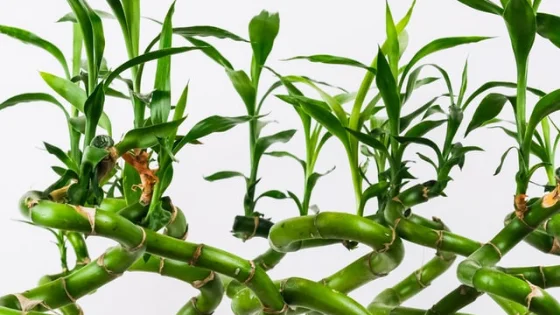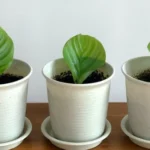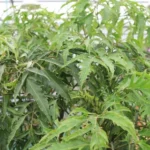Table of Contents
Planting and Caring for your Dracaena Sanderiana (Lucky Bamboo)
With its eye-catching and bamboo-like appearance most people would definitely recognize Dracaena sanderiana when they see it, even if they don’t know its proper name.
Better known and often marketed under the common name lucky bamboo, Dracaena sanderiana is one of the most popular houseplants in the world thanks to its hearty nature and attractive green shoots.
With proper care, the perennial can grow healthily for years. Read on below for the ultimate guide to planting and caring for your Dracaena sanderiana.
Brief History of Dracaena Sanderiana
Although Dracaena sanderiana is often called lucky bamboo due to its fleshy green stalks, the two plants are actually in completely separate taxonomical orders.
Dracaena sanderiana is a tropical West African herbaceous perennial plant whose native range closely resembles the country of Cameroon. It is a part of the shrub family, and its genus name means female dragon in Greek.
The epithet sanderiana is in honor of a famed orchid cultivator named Henry Frederick Conrad Sander (1847-1920).
Although often associated with Asian cultures, beyond its bamboo-like appearance it holds no real history on the continent, though it has become a popular part of the practice of Feng shui.
Planting your Dracaena Sanderiana
Deciding between soil potting and hydroponic options:
Before planting your Dracaena sanderiana you must decide if you are planning on raising your plant in a conventional container with soil or in water hydroponically. Below is a little bit more on the two methods.
Hydroponic with water
Lucky bamboo that is grown in water doesn’t require any soil at all. You will need enough water to at least partially cover the roots, approximately two inches of fresh water to start.
You will also to line the bottom of your container with small stones or pebbles for the roots to catch hold on. Lastly, your lucky bamboo will also require infrequent liquid fertilization.
Plants grown in this manner often produce long green stalks that can be trained to bend into fanciful shapes. They produce less frequent lanceolate shaped leaves per stalk, which gives them their famous bamboo stylings.
Container with soil
Dracaena sanderiana that is grown in dirt is better known by its common name ribbon plant. These plants will take on characteristics more in line with their shrub-like genus.
For example, they will produce thicker clumps of stems and many more leaves in their upthrust foliage. The leaves may also differ in color with white or dark green borders becoming present.
No matter what you choose, every plant will require similar amounts of light, temperature and humidity in order to grow best.
Light Requirements
Dracaena sanderiana is flexible in its light requirements when grown indoors as a houseplant. The plant can thrive in lighting conditions as different as deep shade, with as little as two hours of sunlight a day, to tolerating all day indirect sunlight on its upper canopy.
The most important point about light to remember is that this plant has a low tolerance to direct sunlight and if you are growing it in water this is especially true for any exposed roots.
Temperature Requirements
Dracaena sanderiana is perfectly happy at a regular household temperature. When grown indoors it shows good tolerance as long as it is kept in a space that maintains a temperature in the range of 65- and 90-degrees Fahrenheit.
Humidity Requirements
Because it is native to tropical climates, you might think that Dracaena sanderiana would require humid conditions, which isn’t actually the case.
While it can’t survive desert like conditions, the plant itself doesn’t usually require any additional misting or humidity care as long as it isn’t left in a drafty area.
Soil Requirements
When planting your Dracaena sanderiana in soil be sure to choose a potting mix that isn’t overly fine or gritty. Good drainage is also vital, as root rot may develop otherwise.
Caring for your Dracaena sanderiana
Watering your Dracaena sanderiana
-If your plant is potted in soil, keep the dirt damp, but be sure it is not too wet. If you are worried that the soil may be too dry, try sticking a finger an inch below the topsoil to check and water if you find the soil is flaky.
-If you are growing your plant hydroponically be sure to keep the majority its roots covered at all times.
Top your container off with fresh water often. Change your water completely at least once every two weeks.
How to Fertilize your Dracaena sanderiana
Dracaena sanderiana require very infrequent and weak fertilization. Regardless of style this can be accomplished with feedings approximately every eight weeks.
This can be accomplished one of two ways depending on how your plant is potted.
If you have lucky bamboo in water: simply use one-tenth the usual recommended dose of liquid fertilizer when changing your plants water completely.
If your ribbon plant is potted in soil: it can be fertilized with any household plant fertilizer and done in place of a watering session.
Pruning
While the plant does not require pruning as part of regular care, it may be chosen to be done for aesthetic reasons. Many also use lucky bamboo as part of their practice of Feng shui.
Extra Tips For Dracaena Sanderiana Care
Pests & Diseases
Dracaena sanderiana is particularly hardy when grown indoors as a houseplant. Yet, it isn’t indestructible, be sure to look out for the following warning signs when caring for your own plant:
Leaf Health
The first sign of distress are often displayed in the leaves, be sure to look out for brown or yellowing leaves.
If your leaves look crispy and yellow, your plant is probably getting too much direct sunlight.
If the leaves or stalk appear brown or spotted you may have chemicals in your drinking water hurting the plant, try watering it with distilled water.
Root Health
-f you are growing your plant in water be sure to look out for algae blooms, these occur when your water is getting too much sunlight and fertilizer.
If your plant is in dirt and looks sickly, try to make sure that the top layer of soil is allowed to dry out completely before watering again, this will help prevent root rot.
Pests
Although rare, mites and mealybugs may be a problem in some cases.
For most infestations you can simply remove the bugs manually and treat the stalk and leaves of the plant with a mild rubbing alcohol or detergent.
White fuzz can be a sign of a fungal infection, increase the air flow around your plant if you can and keep stalks and leaves dry as much as possible.
Propagation
Propagating your lucky bamboo is a straightforward process that can be done any time of year.
For the greatest chance of success, it’s recommended to take a cutting off of a green stalk and place it suspended in a container of water to take root.
When looking for a place to cut your stalk, try to find a section just below a leaf or eye and cut away from yourself at a 45-degree angle. Care for your cutting just as you would any regular hydroponic lucky bamboo.
Conclusion
This concludes our ultimate guide to the planting and care of lucky bamboo. We hope that you have enjoyed getting to know more about Dracaena sanderiana and how to care for it and that you learned something new in the process.
Please stay tuned for more information on houseplants and their care and thank you for reading!
Photo by Severin Candrian on Unsplash


